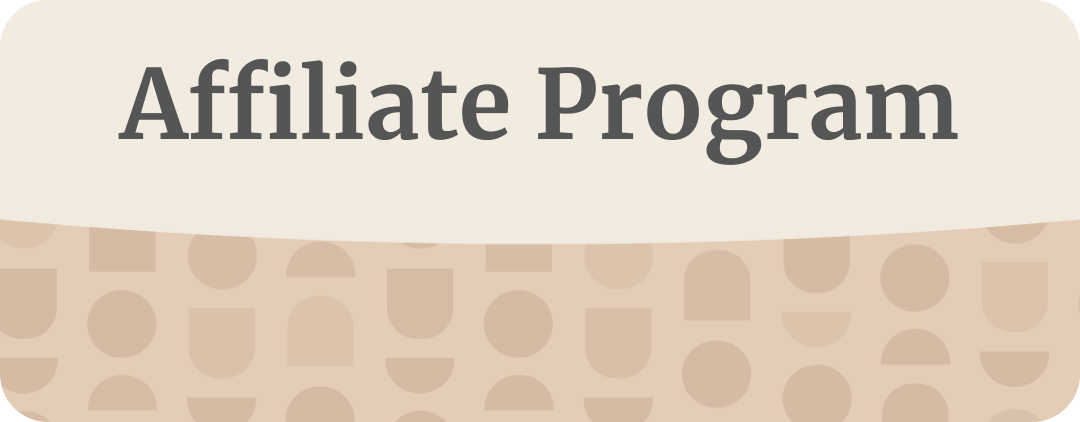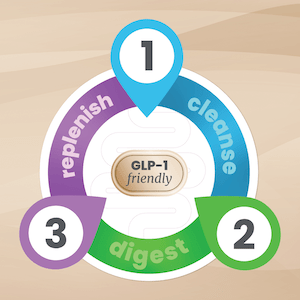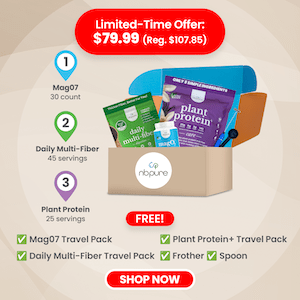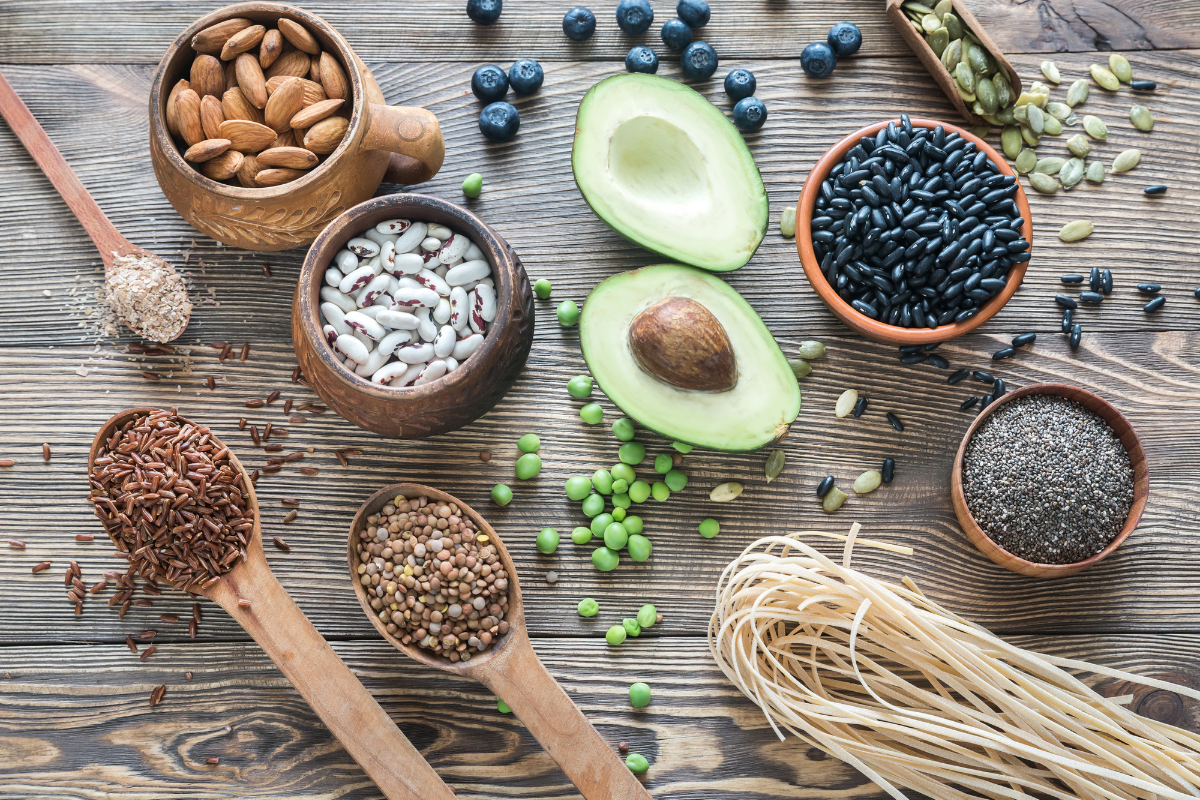written by Lauren Curl-Ferrell on June 3, 2021
All medical data sourced from The National Institute Of Health
2 Types of Fiber: What are they? And How Do You Get Them?
In this article we will be discussing the types of fiber, where they come from, and some food and supplement suggestions on the best ways to get them.
Dietary Fiber
Dietary fiber, also known as bulk or roughage, is the ingestible part of plant-based foods. It passes through the digestive system without being digested or breaking down.
Dietary fiber is incredibly important because it helps to relieve constipation and help food pass through the digestive system easier.
There are also benefits that fiber helps maintain a healthy weight, it lowers the risk of diabetes, certain cancers, and heart disease.
Finding tasty foods and products that provide fiber isn't difficult. The hardest part is making sure you're getting the correct amounts of both types of fiber.
Read on to find out how much dietary fiber you need, some foods that contain it, and easy ways to add them to your meals or snacks.
Fiber recommendations
To have a balanced diet, having dietary fiber is an important part. A study conducted by the National Institute of Health claims that people in the United States receive less than half of their recommended fiber each day.
Here are some recommendations from the Mayo Clinic for the total amount of dietary fiber needed, which includes both types of fiber.
| men, age 50 and under | 38 grams per day |
| women, age 50 and under | 25 grams per day |
| men, over 50 | 30 grams per day |
| women, over 50 | 21 grams per day |
There are two types of fiber - Soluble and Insoluble.
Fiber is classified into two different types. Both are important to a healthy digestive system.
Soluble Fiber:
The first type. dissolves in water. It includes plant pectin and gums.
Insoluble Fiber:
The second, doesn’t dissolve in water and includes plant cellulose and hemicellulose.
Most ingestible plants contain both of these fiber types, but in different amounts. To get the most fiber possible, eat a wide variety of these plants or add a fiber supplement, like Daily Multi Fiber, that contains soluble and insoluble fiber in it.
Soluble Fiber Foods And Supplements
Soluble fiber draws water into your gut. That helps softens the stool and it supports regular bowel movements.
It also helps people feel fuller. It can reduce constipation and can also help lower cholesterol and blood sugar levels (source).
The foods listed below were sourced from Dietitians From Canada
1. Psyllium Husk. Soluble fiber content: 3.5 grams per tablespoon.
2. Fibersol-2. Soluble fiber content: 3 grams per teaspoon.
3. Oats. Soluble fiber content: 1.9 grams per cup (233 grams) of cooked oats
4. Flax Seeds. Soluble fiber content: 0.6–1.2 grams per tablespoon (14 grams) of whole flax seeds
5. Black Beans. Soluble fiber content: 5.4 grams per three-quarter cup (129 grams) of cooked black beans
6. Lima Beans. Soluble fiber content: 5.3 grams per three-quarter cup (128 grams) of lima beans
7. Sweet Potatoes. Soluble fiber content: 1.8 grams per one-half cup (150 grams) of cooked sweet potato
8. Brussel Sprouts. Soluble fiber content: 2 grams per one-half cup (78 grams) of Brussels sprouts
9. Avocados. Soluble fiber content: 2.1 grams per one-half avocado
10. Pears. Soluble fiber content: 1.5 grams per medium-sized pear
11. Broccoli. Soluble fiber content: 1.5 grams per one-half cup (92 grams) of cooked broccoli
12. Figs. Soluble fiber content: 1.9 grams per one-fourth cup (37 grams) of dried figs
13. Turnips. Soluble fiber content: 1.7 grams per one-half cup (82 grams) of cooked turnips
14. Kidney Beans. Soluble fiber content: 3 grams per three-quarter cup (133 grams) of cooked beans
15. Sunflower Seeds. Soluble fiber content: 1 gram per one-fourth cup (35 grams) of sunflower seeds
16. Apples. Soluble fiber content: 1 gram per medium-sized apple
17. Nectarines. Soluble fiber content: 1.4 grams per medium-sized nectarine
18. Barley. Soluble fiber content: 0.8 grams per one-half cup (79 grams) of cooked barley
19. Apricots. Soluble fiber content: 1.4 grams per 3 apricots
20. Carrots. Soluble fiber content: 2.4 grams per cup (128 grams) of cooked carrots
21. Guava. Soluble fiber content: 1.1 grams per raw guava fruit
22. Hazel Nuts. Soluble fiber content: 1.1 grams per one-fourth cup (34 grams) of hazelnuts
Insoluble Fiber Foods
There are actually several different types of insoluble fibers found in various foods, some of which include cellulose and lignin fibers.
1. Oat Fiber. Insoluble fiber content: 9 grams per tablespoon
2. Spinach. Insoluble fiber content: A cup of cooked spinach contains around five grams of insoluble fiber
3. Chard. Insoluble fiber content: A cup of cooked Chard provides around 3 grams.
4. Rasperries. Insoluble fiber content: 7 grams per cup.
5. Blackberries. Insoluble fiber content: 6 grams per cup.
6. Cauliflower. Insoluble fiber content: 4 grams of insoluble fiber per cup.
7. Prunes. Insoluble fiber content: 12 grams of fiber per cup.
8. Almonds. Insoluble fiber content: 14 grams of fiber per cup.
9. Pine Nuts. Insoluble fiber content: 13 grams of fiber per cup.
10. Peanuts. Insoluble fiber content: 10 grams of fiber per cup.
11. Pistachios. Insoluble fiber content: 10 grams per cup.
12. Peas. Insoluble fiber content: 15 grams per cup.
13. Unpeeled Apple. Insoluble fiber content: 3 grams per medium sized apple.
14. Roasted soybeans. Insoluble fiber content: 17 grams per cup.
15. Cooked Pinto Beans. Insoluble fiber content: 11 grams per cup.
Soluble vs. Insoluble Fiber Chart

Benefits of each type of fiber
Both fibers have many different and unique fibers.
Insoluble fiber will attract water into your stool. Which in turn, makes it easier and softer to pass. It also makes the bowel movement much easier to pass. It will support insulin sensitivity and can reduce the risk of diabetes. Also, insoluble fiber is a champ at promoting nice and regular bowel movements.
As soluble fiber dissolves, it creates a gel that may improve digestion in a number of ways. Soluble fiber will help the body with better blood glucose levels and control. Also, it may reduce blood cholesterol and sugar. This also helps with reducing the risk of diabetes, much like insoluble fiber.
Dietary Fiber and Health Issues Overall
Yes, dietary fiber does do a lot to support your gut health, but it can also promote better health through out the entire body. Having the right amount of overall dietary fiber intake can help with many other health issues.
It can:
-
control body weight
-
lower the risk of colon cancer
-
lower the risk of breast cancer
-
control and possibly prevent hypertension
-
help balance cholesterol levels in blood
-
regulate blood sugar
-
regulate bowel movements
-
prevent hemorrhoids
-
help with the body's satiation signals.
-
lower risk of diabetes
The Wrap Up
Getting fiber can be easy, as long as you know what to look for and how much you need. At the end of the day, if you find it difficult, like most people - to eat all the fiber foods, simply add a supplement to your line up. Daily Multi Fiber is the only supplement on the market that uses soluble and insoluble fiber so you can get the best of both types.


















